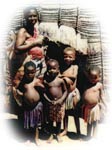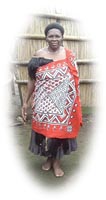Swazi Lifestyle: Traditional Attire
SNTC, 2000.
There is a wide range of traditional attire related to different cultural ceremonies, as well as day-to-day usage. Traditional attire is specific to gender and age group, and some items are only to be worn during specific traditional ceremonies, such as the incwala or the umhlanga (reed dance).
Traditional attire for daily use
 |
Age: up to 3 months
both male and female wear only protective medicines |
 |
Age: 3 months to 3 years |
| males wear tiny loin skin |
females wear nothing or string of
beads |
 |
Age: 3 to 8 years
|
 |
| males wear loin skin |
females wear string of beads and skirt of grass or cloth |
| Age: 8 to 17 years males wear loin skin and start to wear penis cap |
 |
Age: 8 to 15 years females wear skirt of grass or skirt and short toga of cloth, never long; bead necklaces
|
 |
Age: Unmarried adults |
| males wear loin skins and cloth, bead ornaments |
females wear a dress of cloth, hair up, but in a small bun |
 |
Age: Married adults |
 |
| males wear loin skin, cloths |
females: newly-weds wear skin apron and skin skirt, apron worn under the armpits; after birth of first child, raises apron over one shoulder; hair in a bun |
 |
Age: Grandparents
|
 |
| males wear loin skin, cloths and head ring |
females wear goatskin and cloths, hair in bun |











